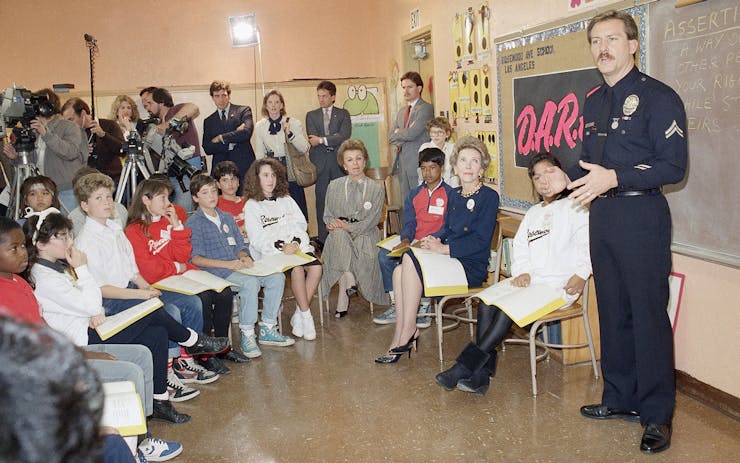In the late 1990s, schools in New York set out to keep their kids safe from drugs. They partnered with a youth program to distribute pencils with an anti-drug slogan that read: “TOO COOL TO DO DRUGS.” This was all well and good until students sharpened their pencils, morphing the message:

(WestLight/iStock)
People mean well. They really do. But the best laid plans of mice and men often go awry and anti-drug youth programs are no exception.
Remembering other messages from the war on drugs, much of the information was wildly off-base—which actually led to me largely writing off adult warnings in general, as they seemed ill-informed and untrustworthy.
And it turns out, I wasn’t the only kid who conversely wound up more likely to use intoxicants after exposure to anti-drug programs and messaging: When the effects of a largely government-funded national youth anti-drug media campaign were studied, scientists discovered that not only did the near-billion-dollar program not work, it had the opposite effect on some youths. This boomerang effect resulted in youths who were exposed to the ads being 4% more likely to use intoxicants.
When theorizing why, some relate to my perspective—that exaggeration ruined the credibility of the messaging. Others posit that the heft of the widespread campaign unintentionally led to the perception that “everyone’s doing it,” making it more socially appealing.
So, what’s it like nowadays? While the anti-drug messaging for people who grew up in the ’80s wasn’t as bad as the Reefer Madness propaganda from the ’30s, today’s messaging hasn’t progressed as much as I was hoping to discover. Yesterday’s “This is Your Brain on Drugs” is today’s Stoner Sloth, but things are changing.
Cannabis Education in a Legal-ish World
I recently saw a table for the popular anti-drug program D.A.R.E. on my way into a grocery store and laughed because their logo remains completely unchanged—despite the fact that it has now become an ironic symbol, daring people to do drugs. I was stunned that they could still be so unaware.
After repeated studies showed that the ubiquitous D.A.R.E. didn’t work, and sometimes had the opposite effect, D.A.R.E. enlisted the help of a program called keepin’ it REAL (kiR). I spoke with Michelle Miller-Day, PhD, President of the organization REAL Prevention, which created kiR. D.A.R.E added kiR’s evidence-based program to their curricula in 2012, and has also added videos, with separate content for rural, urban, and suburban youth.
Miller-Day says the fearmongering of the past is indeed behind us. “Instead, the emphasis in prevention today is about social and emotional competencies to handle things like responsible decision-making, positive and negative risks, communication skills, stress management and mindfulness, and emphasizing social support in dealing with stressful situations that often lead youth to self-medicate.”
This time, science says they’re onto something with this report from the Substance Abuse and Mental Health Services Administration (SAMHSA).
D.A.R.E. reports that it continues to improve, telling Scientific American in 2014 that they want to be on the “cutting edge of research and science.” However in 2015, they shared a satirical article claiming, “4 Teens Become Pregnant for Every Joint Smoked,” so one wonders if they’ve actually stuck to their old fearmongering policy. (D.A.R.E. declined requests for an interview.)
What’s the Science on How Cannabis Affects Teen Health?
Teens are highly capable of discerning whether what they’re being taught is a load of shinola. Actual facts, and their context, are crucial in developing credibility with teens who employ critical thinking—a skill so often taught in the very schools using these anti-drug programs.
Shop highly rated dispensaries near you
Showing you dispensaries nearIf you’re a regular Leafly reader, you probably know where this is headed—we need more science on how cannabis affects health. How exactly it affects a teen’s body isn’t yet conclusive and some studies are misleading.
Teens With a Low IQ
This long-term study from Duke University on people in New Zealand reports a lower IQ in teens who use cannabis, however, it’s troubled by a problem many cannabis studies face: the chicken-egg dilemma. Situational and/or health conditions that already exist can lead someone to use cannabis for relief and self-medication in some way—a connection between a health issue and cannabis doesn’t mean that the plant caused the condition.
In the New Zealand study, the teens already had lower IQs. Dr. Gregory Tau, a psychiatrist and drug abuse researcher at Columbia University, told NPR: “It’s very possible that there’s something very different to begin with among teenagers who tend to get into trouble with marijuana or who become heavy users. They could have subtle emotional differences, perhaps some cognitive functioning differences … It may be hard for them to ‘fit in’ with a peer group that’s more achievement-oriented.”
Dr. Tau concludes that these differences could predispose a teen to turn to cannabis to cope with something difficult—here, having a lower IQ than peers—not the other way around.
Schizophrenia
Similarly, another popular claim is that teen-use causes schizophrenia—this has been debunked by many for the same chicken-egg problem, with sufferers using cannabis to self-medicate for their condition.
Cannabinoid Hyperemesis Syndrome
Cannabinoid hyperemesis syndrome is a condition that can develop in people who’ve used cannabis heavily for a long time. People with this condition develop cyclic vomiting, intense abdominal pain, and an overwhelming urge to bathe in hot water for comfort. And while that may seem like the fantasy of an anti-cannabis organization, there’s no anti-drug scare tactics or exaggeration in that description—I actually had a roommate who unfortunately developed it.
However, there’s a popular misunderstanding in this regard as well. Experts in teen drug education have shared that syndrome’s frequency nearly doubled in Colorado after legalization, a highly troubling statistic at first glance. But the condition takes several years of cannabis use to develop, and the study was done just one year after legalization, so not enough time lapsed between legalization and the syndrome’s rise.
What Should We Be Telling Youths?
To me, it’s a mystery why organizations aren’t telling kids about the endocannabinoid system (ECS). This network of receptors that exists throughout the body—with concentration in the brain and spinal cord—is responsible for maintaining the correct balance of all other systems in the body. (It’s the reason cannabis is so useful medically.) We know frustratingly little about the ECS, as the medical field has ignored it for decades, but we do know it’s a big deal.
The ECS does plays a significant role in adolescent development. As a fighter of fibromyalgia, one of the conditions thought to be caused by ECS malfunction, I wonder if the 19-year-old version of me, who did regular gravity bongs (out of an enormous Cheetos container) and spent most of her time in the circle, totally screwed current-me over.
Who knows, maybe I’d have better health today if teen-me had been exposed to science-based messaging regarding cannabis, like this program’s “Delay, delay, delay,” rather than an egg on a frying pan, which actually left me with oodles of questions.
So how does one effectively communicate the importance of a potential risk to someone during a stage of life when they feel invincible and rebellious? Something that may be potentially harmful in the future may not be pressing to a teen desperate to have all the experiences right now. But this communication is important.
The biggest strides of progress in this realm will be clear and conclusive facts. So, it’s up to scientists, and those who fund their studies, to give educators the tools they need to inform youth about how cannabis can affect their lives and bodies.
And for now, D.A.R.E.—perhaps a redesign is in order?





